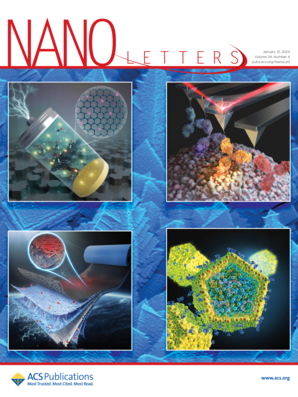Nanofluidic Memristive Transition and Synaptic Emulation in Atomically Thin Pores
IF 9.6
1区 材料科学
Q1 CHEMISTRY, MULTIDISCIPLINARY
引用次数: 0
Abstract
Ionic transport across nanochannels is the basis of communications in living organisms, enlightening neuromorphic nanofluidic iontronics. Comparing to the angstrom-scale long biological ionic pathways, it remains a great challenge to achieve nanofluidic memristors at such thinnest limit due to the ambiguous electrical model and interaction process. Here, we report atomically thin memristive nanopores in two-dimensional materials by designing optimized ionic conductance to decouple the memristive, ohmic, and capacitive effects. By conducting different charged iontronics, we realize the reconfigurable memristive transition between nonvolatile-bipolar and volatile-unipolar characteristics, which arises from distinct transport processes governed by energy barriers. Notably, we emulate synaptic functions with ultralow energy consumption of ∼0.546 pJ per spike and reproduce biological learning behaviors. The memristive nanopores are similar to the biosystems in angstrom structure, rich iontronic responses, and millisecond-level operating pulse width, matching the biological potential width. This work provides a new paradigm for boosting brain-inspired nanofluidic devices.

求助全文
约1分钟内获得全文
求助全文
来源期刊

Nano Letters
工程技术-材料科学:综合
CiteScore
16.80
自引率
2.80%
发文量
1182
审稿时长
1.4 months
期刊介绍:
Nano Letters serves as a dynamic platform for promptly disseminating original results in fundamental, applied, and emerging research across all facets of nanoscience and nanotechnology. A pivotal criterion for inclusion within Nano Letters is the convergence of at least two different areas or disciplines, ensuring a rich interdisciplinary scope. The journal is dedicated to fostering exploration in diverse areas, including:
- Experimental and theoretical findings on physical, chemical, and biological phenomena at the nanoscale
- Synthesis, characterization, and processing of organic, inorganic, polymer, and hybrid nanomaterials through physical, chemical, and biological methodologies
- Modeling and simulation of synthetic, assembly, and interaction processes
- Realization of integrated nanostructures and nano-engineered devices exhibiting advanced performance
- Applications of nanoscale materials in living and environmental systems
Nano Letters is committed to advancing and showcasing groundbreaking research that intersects various domains, fostering innovation and collaboration in the ever-evolving field of nanoscience and nanotechnology.
 求助内容:
求助内容: 应助结果提醒方式:
应助结果提醒方式:


